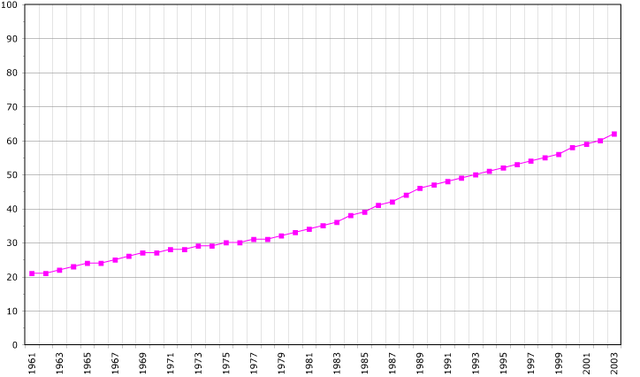Top Qs
Timeline
Chat
Perspective
Demographics of American Samoa
From Wikipedia, the free encyclopedia
Remove ads
Demographics of American Samoa include population density, ethnicity, education level, health of the populace, economic status, religious affiliations and other aspects. American Samoa is an unincorporated territory of the United States located in the South Pacific Ocean.

Population
The statistics from 1900 to 1950 and every decennial census are from the U.S. Census Bureau. There was no census taken in 1910, but a special census taken in 1912. Beginning with the 1930 Census, Swain Island is included in the population count for American Samoa. The remaining statistics are from the World Factbook, unless otherwise indicated.[1]
Remove ads
Structure of the population
Population by Sex and Age Group (Census 01.IV.2010): [7]
Remove ads
Vital statistics
Registered births and deaths
Ethnic groups
- Pacific Islander 92.6% (includes Samoan 88.9%, Tongan 2.9%, other 0.8%)
- Asian 3.6% (includes Filipino 2.2%, other 1.4%)
- Mixed 2.7%
- Other 1.2% (2010 est.)
Languages

Native languages include:
English proficiency is very high.
Religion
Summarize
Perspective
- Christian 98.3%
- Other 1%
- Unaffiliated 0.7% (2010 est.)
Major Christian denominations on the island include the Congregational Christian Church in American Samoa, the Catholic Church, the Church of Jesus Christ of Latter-day Saints and the Methodist Church of Samoa. Collectively, these churches account for the vast majority of the population.[11]
J. Gordon Melton in his book claims that the Methodists, Congregationalists with the London Missionary Society, and Catholics led the first Christian missions to the islands. Other denominations arrived later, beginning in 1895 with the Seventh-day Adventists, various Pentecostals (including the Assemblies of God), Church of the Nazarene, Jehovah's Witnesses, and the Church of Jesus Christ of Latter-day Saints.
The World Factbook 2010 estimate shows the religious affiliations of American Samoa as 98.3% Christian, other 1%, unaffiliated 0.7%.[1] World Christian Database 2010 estimate shows the religious affiliations of American Samoa as 98.3% Christian, 0.7% agnostic, 0.4% Chinese Universalist, 0.3% Buddhist, and 0.3% Baháʼí.[12]
According to Pew Research Center, 98.3% of the total population is Christian. Among Christians, 59.5% are Protestant, 19.7% are Catholic and 19.2% are other Christians. A major Protestant church on the island, gathering a substantial part of the local Protestant population, is the Congregational Christian Church in American Samoa, a Reformed denomination in the Congregationalist tradition. As of August 2017[update], The Church of Jesus Christ of Latter-day Saints website claims membership of 16,180 or one-quarter of the whole population, with 41 congregations, and 4 family history centers in American Samoa.[13] The Jehovah's Witnesses claim 210 "ministers of the word" and 3 congregations.[14]
Remove ads
References
Wikiwand - on
Seamless Wikipedia browsing. On steroids.
Remove ads
